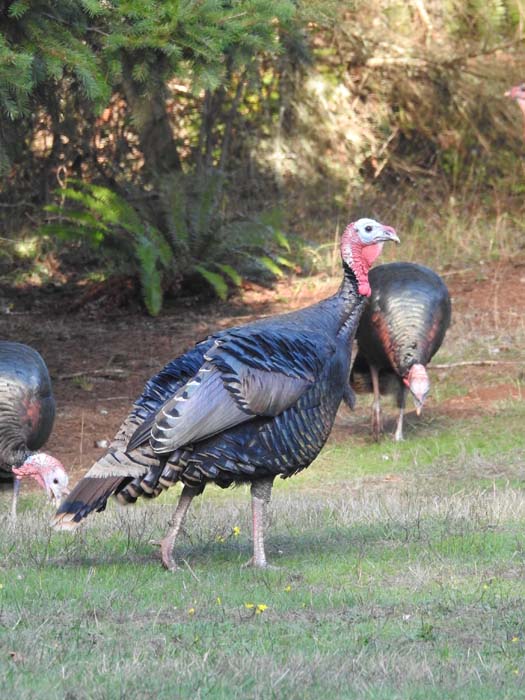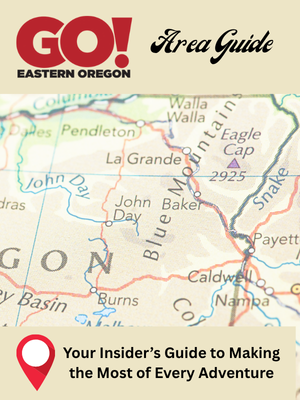Turkey hunting season underway
Published 2:30 pm Wednesday, April 10, 2024

- Wild turkeys prefer edge habitat with oak trees and pines adjacent to land used for crops and livestock.
PENDLETON — Oregon’s statewide spring wild turkey hunting season opened April 15, and the general season continues through May 31.
Hunters can buy up to three turkey tags for the spring season.
The daily bag limit is one male wild turkey, or a turkey with a visible beard.
Hunters can buy tags through the end of the season.
Hunters have two options to tag turkeys: paper tags or electronic tags. Hunters choose one option when they buy tags.
It is illegal to hunt turkeys with shotguns larger than 10-gauge or shot size larger than No. 2.
Some turkey hunters use a bow rather than a shotgun.
Since their introduction to the state in 1961, Oregon’s turkey population has grown to well over 30,000 today, according to the Oregon Department of Fish and Wildlife. Throughout that time, ODFW has transplanted over 10,000 birds from established flocks to many new parts of the state.
More information about turkey hunting in Oregon, including tips for choosing a weapon and clothing, calling techniques and ways to care for turkey meat, is available at https://myodfw.com/learn/collection/how-to-hunt-wild-turkey-in-oregon/skill/turkey-hunting-in-oregon.
Spring is prime turkey hunting season, as this is the bird’s breeding season. Hunters who set up in a well-camouflaged spot and use a call can sometimes lure a male turkey into shooting range.
Turkey season outlook
About 47% of the turkeys harvested during the spring 2023 season were killed east of the crest of the Cascade Mountains, according to the ODFW.
After the White River Unit, the Heppner and Ochoco units produced the most turkeys, followed by Sled Springs, Ukiah, and Mount Emily. Wild turkeys can be found throughout the Blue Mountains, where access is good due to the amount of public land, most in national forests.
In most years, birds take advantage of open southern exposures at higher elevations, according to ODFW. Hunters should expect to find high country turkeys around the snow line enjoying fresh spring greenup. It is important for hunters to check road conditions and access before heading out, especially early in the season. Snow may limit access to some areas.
Baker County
Turkey numbers going into the winter were good in Baker County. A mild winter with favorable conditions in the late fall should have led to good overwinter survival. Turkeys are widely distributed throughout the county.
Things are just starting to green up at lower elevations and hunters should concentrate their efforts near these areas. Hunters can improve their early season success by walking into areas that are not accessible by vehicles due to snow.
The Pine Creek, Sumpter and Keating units all hold good numbers of birds on public land. Remember to ask for permission before hunting on private property.
Grant County
Turkeys are widely distributed, and numbers continue to increase throughout the county. Last year’s chick production and survival appear to be very good. Due to unseasonably warm weather at the end of March, the forests will be more accessible than usual during the early part of the season. However, substantial snowdrifts may still be present on north-facing corners so hunters should use caution.
During early season, some turkeys may persist on private property and hunters will need permission to hunt. However, most birds start to move up slope to forest land about the middle of April. Hunter may focus on the forest edge as birds move up. Hunters have been successful in finding birds in the Middle Fork John Day River, Murderers Creek, and North Fork John Day River drainages.
Other drainages recommended for hunters who are unfamiliar with the area are Ingle Creek, Fields Creek and Deer Creek in the Murderers Creek Unit. In the Northside Unit, hunters may try Camp Creek, Pass Creek, Fox Creek, and Cottonwood (but much of Cottonwood is private), Dixie Creek or the large tracts of national forest. In the Desolation Unit, hunters may focus in the areas of Big Creek, Mosquito Creek, Vinegar Creek or Desolation Creek.
Umatilla County
Below-average snowfall at lower elevations should lead to better access early in the season. There are good numbers of turkeys all along the front face of the Blue Mountains and they are expanding into new areas. These areas are dominated by private land and access is sometimes difficult. However, turkeys do inhabit public land in these areas:
• Central and south Ukiah Unit throughout Umatilla National Forest lands.
• Northern Ukiah Unit on the Meacham Travel Management Area.
• Umatilla National Forest in the eastern portion of the Heppner Unit.
• Mount Emily Unit on Umatilla National Forest lands on ridges below Black Mountain.
• The Walla Walla Unit also has turkeys on lands enrolled in ODFW’s Access and Habitat program. Turkeys in the Ukiah Unit generally are found in relatively flat terrain in open ponderosa pine habitat. Turkeys in Mount Emily tend to avoid steeper areas and inhabit flatter ridgetop areas. These can be challenging to access until later in the season and in some years, they are inaccessible due to snow.
Union County
Turkeys are widely distributed throughout the county. The winter was fairly mild, and turkey populations going into winter were strong, so with expected high overwinter survival turkey numbers should be high for this spring season. Lower elevations should have good access, and higher elevations will be accessible earlier than in years past. Focus on these lower elevations early on in the spring and follow the snowline. Birds may use areas with residual snow cover, so don’t overlook these spots when scouting for new hunting locations.
Look for birds at the north end of the Grande Ronde Valley, Palmer Valley and the south end of the Catherine Creek Unit. The highest concentrations of birds will be in the west Sled Springs, Wenaha and east slopes of the Mount Emily units within Union County. The Wallowa-Whitman National Forest and Manulife Timber lands both hold great turkey habitat around the edges of the Grande Ronde Valley, such as Spring Creek, and the national forest area surrounding Vey Meadows.Manulife lands are open to the public and provide several walk-in hunting opportunities within Union County.
The Little Catherine Creek Travel Management Area provides access into road systems on the east side of the Grande Ronde Valley; maps are available at the La Grande ODFW office and online. At Ladd Marsh Wildlife Area, turkeys can be found on Glass Hill. These birds spend their time in the transition between the open fields and the dense forest feeding and traveling amongst the brush.
Wallowa County
Turkey hunters can expect good numbers of birds in most areas of the county. Road access to high elevations is expected to be difficult due to snowdrifts through April. Snow is mostly gone from low-elevation areas and south-facing slopes, providing green forage for birds. Access may also be affected by 2022 fires, especially in the Snake River Unit. Plan ahead and check with the local Forest Service office for any closures.
Turkeys in the valley are already displaying but birds are beginning to scatter throughout forested areas so hunters should put in some time hiking, listening and looking for signs of turkey activity. Call for them or just listen for their calls early in the morning and late in the evening. Hunters are reminded that cooperative travel management areas are in effect in the Wenaha and Sled Springs Units.









